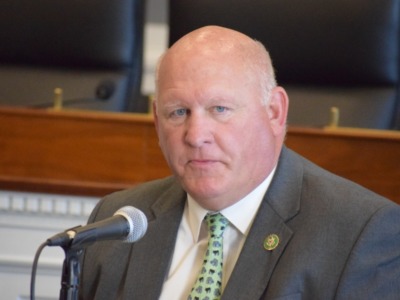Congressional Agriculture Committee leaders are providing glimpses into their intentions for farm bill conservation programs with proposals to make potentially significant changes to longstanding programs such as Conservation Reserve Program and to create new ones.
The proposals are included in a broad outline released by House Agriculture Committee Chairman Glenn "GT" Thompson, R-Pa., and a far more detailed, section-by-section summary released by Senate Agriculture Chairwoman Debbie Stabenow, D-Mich.
Thompson has moved closer to Stabenow on funding the conservation title. Both want to bring $13 billion in Inflation Reduction Act funding into the farm bill, but Thompson wants to remove restrictions on the money that now limits it to climate-smart practices.
 House Ag Chairman Glenn "GT" Thompson, R-Pa.
House Ag Chairman Glenn "GT" Thompson, R-Pa.Thompson said the IRA funding could be shifted to other programs within the title where it's needed more. “But it would all be in conservation,” he told Agri-Pulse.
Ferd Hoefner, former policy director for the National Sustainable Agriculture Coalition, said it matters which conservation programs would lose IRA funding to other priorities, such as CRP or the Forest Conservation Easement program. The IRA funding currently is allocated to four — the Regional Conservation Partnership Program, the Conservation Stewardship Program, the Environmental Quality Incentives Program and the Agricultural Conservation Easement Program.
“Somebody’s ox is getting gored, they’re just not saying whose,” Hoefner said.
One major change in Stabenow's bill would permanently authorize several programs, including CRP, the Conservation Reserve Enhancement Program, the Farmable Wetlands Program, Clean Lakes Estuaries and Rivers (CLEAR), the Soil Health and Income Protection Program (SHIPP), the State Acres for Wildlife (SAFE) Program and the Grazing Lands Conservation Initiative.
“I actually think this is a pretty important policy move,” said Jonathan Coppess, University of Illinois farm policy analyst. “I realize it’s deep in the weeds of these programs and authorizations, but it’s one of those things that I think has really positive longer-term implications.”
Crop insurance already has permanent authorization and the farm bill's single biggest cost item, the Supplemental Nutrition Assistance Program, is reauthorized in the appropriations process.
When it comes to CRP, the Senate bill would shift acreage toward its grasslands signup and away from the traditional signup process that focuses on idling large tracts of land.
CRP is currently divided into three major signups: general, continuous and grasslands. General CRP focuses on retiring whole fields from production for 10- to 15-year periods, while continuous CRP targets smaller parcels through practices like buffers and filter strips. Grassland CRP allows grazing enrolled land. Grazing is allowed in emergency conditions under general signup.
Stabenow’s bill would gradually increase CRP’s 27-million-acre cap to 29 million acres by 2029, where it would be set permanently. The would increase the minimum number of acres that could be enrolled in the grasslands signup — currently 2 million acres — to 10 million acres, while adding a 12-million-acre cap for grasslands. Rangeland, pastureland and land suitable for silvopasture would become eligible for the grassland signup, according to the summary.
Farmers looking to re-enroll in the general signup would be able to receive 95% of their county’s average cash rental rate under the Senate bill, rather than 85%. Those looking to re-enroll in continuous would be able to secure 100% of the average rental rate instead of 90%.
Cut through the clutter! We deliver the news you need to stay informed about farm, food and rural issues. Sign up for a FREE month of Agri-Pulse here.
It would also allow “land planted with multi-year grasses and legumes to be considered to have a cropping history for the purposes of program eligibility.”
 Lynn Tjeerdsma
Lynn TjeerdsmaLynn Tjeerdsma, long-time conservation policy maven and former adviser for Sen. John Thune, R-S.D, worries opening up general CRP to grasslands would hinder its ability to take fragile cropland out of production. One of the main benefits of focusing on marginal cropland, he said, is it reduces the amount of money that goes toward crop insurance indemnities and disaster payments.
“It seems like CRP is headed more to not meeting those goals like it used to,” he told Agri-Pulse.
In addition, the Senate proposal would create a new program allowing easements for expired CRP land.
The House’s overview, while short on details, also indicates changes to CRP, updating the program by “incentivizing enrollment of marginal lands and emphasizing state partnerships.”
A GOP staffer told Agri-Pulse last year that House Ag Republicans were eyeing major reforms to CRP, including eliminating the national acreage cap in lieu of a limit on funding, though Hoefner said he’s been told they have backed off that idea.
Hoefner has heard House Republicans are now looking at increasing the acreage cap to 29 million acres. To appease concerned agricultural groups, he said they’re planning to also “throw in” some provisions to force the Farm Service Agency "to really keep this to marginal lands.”
Tjeerdsma, while unsure of House lawmakers’ plans, believes their reference to “marginal lands” could be indicating potential changes to CRP’s rental rate structure.
The House bill would establish a Forest Conservation Easement program that would be “a forest-focused complement” to ACEP, according to Stacia Stanek, director of government relations for the Conservation Fund, a major proponent of creating the program.
FCEP would allow landowners to enter into forest land easements (FLE) with conservation organizations, states, tribes and local entities or forest reserve easements (FRE) with the Natural Resources Conservation Service. Timber harvesting would still be allowed on forest easements through the program.
The FRE portion of the program would be an expansion of the current Healthy Forests Reserve Program, which offers some forestland easement options. Working forestlands are not currently eligible for USDA's main easement program, the Agricultural Conservation Easement Program.
“Our goal is for FCEP to have broader forest land eligibility than existing federal forest easement programs have,” Stanek said. “It's really about filling those gaps in federal forest easement programming to be able to conserve forest lands at scale.”
In EQIP, the Senate framework would create a 10% set-aside for small farms, require producers with confined livestock feeding operations to submit emissions reduction plans to get payments and allow participants to reduce the term of their contract in order to enroll in the CSP.
CSP changes in the Senate framework would give more weight to carbon sequestration and greenhouse gas emission considerations in the application ranking process, allow payments for transitioning to organic production and allow soil testing as an eligible conservation activity.
One climate-focused measure in the Senate proposal outside the conservation title would require USDA to create a “standardized methodology to directly measure soil carbon consistently over time for research and conservation purposes.”
It would also create a program for monitoring and inventorying “soil carbon changes on eligible land in the United States” and would require USDA to “maintain a modeling tool to predict the impacts of different land management practices.” Of the $50 million that would be authorized for the program, 30% would be dedicated to historically underserved producers.


